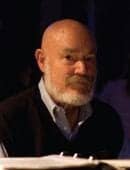Acoustic engineer who invented the acoustic suspension loudspeaker, dome tweeter, and multiband compression hearing aid, and brought fundamental change to two different fields.

Edgar Villchur raises a cup of coffee to the New Year, December 2006.
Editor’s Note: Acoustic pioneer Edgar Villchur, PhD, passed away on October 17, 2011 at age 94. The following is the eulogy that Dr Killion presented at Dr Villchur’s funeral on October 23 in Woodstock, NY.
I met Edgar Villchur in 1968 at an Audio Engineering Society meeting in New York City. We met in front of the Bruel & Kjaer booth looking at test equipment. We somehow struck up a conversation about the proper way to measure the real ear response of earphones, and each of us quickly concluded that the other was an idiot. We somehow got past that, and finally realized that we were each looking at different ways to measure the same thing. Even more surprisingly, we became friends.
He decided that it would be a kindness to show this young kid from Battle Creek, Mich, some of the big city, and asked if I had ever been to a New York Jewish delicatessen, which I hadn’t. As we were walking toward the Carnegie Deli, he said, “I should tell you about Jewish waiters. Their job is to be as rude as possible to the customer, and the customer’s job is not to back down.” When we were seated, the dialog started: “What’ll it be, gentlemen?” Eddie said, “I’ll have plain cheesecake.” To Eddie’s delight, the waiter, visibly insulted, said, “So what’s wrong with the cherry cheese?” Eddie played his role and said, “Probably nothing, but I’m a difficult customer.” To which the waiter said, “I vuldn’t ahgue!”
Many of Eddie’s favorite jokes centered around the traditional game of hostility and one-upmanship played between a Jewish waiter and a Jewish customer, jokes which he told with great skill and delight. A highlight at my own company’s annual meeting was the wine and cheese party the night before, where Eddie, Professor Chuck Berlin, and Don Chatfield, a professor of preaching at Garrett Seminary, told jokes—Jewish and otherwise—with extraordinary enthusiasm.
Eddie was not a religious man, but he was an extraordinarily ethical man, who had a wonderful knowledge of the traditions and writings of not just Judaism but of all the important religious faiths. Both my parents were Protestant preachers, but I often found Eddie knew “my” Bible much better than I did. Some of his best letters-to-the-editor to the New York Times pointed out that the moral belief under discussion couldn’t be decided on religious grounds, because the Christian Bible, the Torah, and/or the Koran took opposing positions on the topic. Some people spent a lifetime trying to get one such letter published in the Times. Eddie published 22 of them.
His writing principles were straightforward: Make the literal meaning of words and sentences identical to the context meaning. Trim. Shorten. Cut out repetition. Write for clarity. Don’t use mathematics to impress the readers—they won’t be impressed.
In some 150 published papers and several books, Eddie followed those same clear writing principles. For that, and for his many scientific contributions, the American Auditory Society gave Eddie its fifth Lifetime Achievement Award in 1995.
Once we became friends, Eddie was kind enough to edit most of my scientific papers. After nearly 40 years of editing, he finally gave me a high compliment: “I didn’t find much wrong with that manuscript.”
I once asked him to write on writing. His advice is contained in a collection on Good Writing, which can be found on the Web at www.etymotic.com/publications/erl-0033-1996.pdf.
Eddie wrote several excellent books, but in my view his crowning achievement as a book writer was his Acoustics for Audiologists (Singular Publishing, 1999). In only 125 pages, he covered all the important findings of the last two centuries about acoustics, sound reproduction, and the limits of normal and impaired hearing….
I suspect most of you know that he created a loudspeaker that changed forever how loudspeakers were made. He was teaching a course on high fidelity at NYU and got to thinking about how silly it was that the “spider” that centered the voice coil in loudspeakers was very stiff, which made it necessary to use a very large cabinet to get good bass. Even sillier, as he thought about it, was that the stiff spider itself was inherently nonlinear and so introduced large distortion in low bass notes at full organ volume. As he described it later, he simply reversed the two stiffnesses, making the spider stiffness low and the air stiffness high, which forced him to use a small cabinet! Other writers often suggested he wanted a small cabinet, but the goal was a superior performance; the small cabinet was a bonus.
One of the most difficult challenges with his new design was to fabricate the highly flexible surround between the paper loudspeaker cone and the metal supporting cage. [His wife] Romy [Rosemary] became involved because she had been a student draftswoman during the war. Eddie was forever annoyed at the press for making light of her participation. As the press put it, “The little woman came to the rescue with her scissors.”
Eddie never wanted to manufacture loudspeakers; he wanted to license his new “acoustic suspension” loudspeaker design and go back to teaching and writing. He once wrote, “The real satisfactions for me have come from analyzing a practical problem with the aid of the physical sciences, working out a solution, and finding out that you are right.”
Fortunately, he failed in his attempts to license his new breakthrough. The president of the Bozak loudspeaker company wouldn’t even listen to it, saying, “It’s impossible to get that much bass out of a small box.” The president of the Electrovoice loudspeaker company said, “If such a thing were possible, our engineers would have discovered it!” The funniest was a writer who explained that the reason it was impossible to get real bass out of a small box was that the wavelength of sound at 30 Hz was too large to fit in such a small cabinet. (By his reasoning, such a cabinet would need to be 37 feet long to reproduce a 30 Hz signal!)
After that came a dome tweeter, his second major loudspeaker innovation. Nearly every high-quality loudspeaker today uses one or both of Villchur’s innovations: Acoustic Suspension and Dome Tweeters.
Having far and away the best product is often not enough to ensure success, but Eddie also had a flair for accurate, compelling ads and demonstrations. After several years, AR had captured 32% of the hi-fi loudspeaker market—no one before or since has exceeded 10%.
His most dramatic demonstrations were the live-vs-recorded demonstrations. In one, he showed that his loudspeakers could reproduce the organ in Boston Symphony Hall so well that few people could detect a difference. He also traveled with the Fine Arts Quartet giving concerts in which the playing of the string quartet alternated with his loudspeaker reproduction of that quartet (previously recorded on the lawn of the Villchur home). Throughout the live-vs-recorded concerts, the players would often pretend to play in order to hide the moment of transition from live to recorded. After the formal concert, the quartet did a demonstration in which they asked people to raise their hands when they heard the transition. The players appeared to start and stop playing, and people in the audience raised their hands at various times. Afterwards, when it was revealed that this entire demonstration had used recorded music, the few diehards who had raised their hands signaling that they had clearly heard a difference were exposed.
By 1967, Eddie decided there were no important problems left to solve in high fidelity reproduction, and he saw hearing aids as the next unsolved problem to tackle. He formed the Foundation for Hearing Aid Research and from then on worked out of a well-equipped lab in several rooms in the back of the Villchur home in Woodstock.
After creating the foundation, Eddie no longer patented his innovations, but gave them away through publication. The most important publication was his 1973 paper on multiband compression. That is one of the most often cited papers in audiology, referenced in over 170 other publications. He followed it up in 1974 with a paper describing an electronic simulation of what it sounded like to someone with a hearing loss listening a) without a hearing aid, b) with a traditional hearing aid, and c) with the 2-channel compression hearing aid .
During 40 years at the Foundation for Hearing Aid Research, Eddie published many of his 150 papers. The most recent was when he was 90. I was allowed to co-author that paper because we had had heated discussions over the proper mathematical treatment of his data. As I recall, he won in the end, but he liked the arguments because they checked his own reasoning.
Before anyone had produced a hearing aid using Eddie’s multi-channel compression principle, he decided to test it on subjects. He asked me to build a special suitcase containing a portable hearing aid with three channels of compression. He took it to Albert Einstein University each week for a year and tested it on profoundly deaf subjects in order to determine how much those with profound loss might be able to benefit. Another important research paper resulted.
He brought about fundamental and permanent changes in two different fields. His multi-channel compression amplified only soft sounds, leaving loud sounds unamplified or amplified much less. It became the ReSound hearing aid, which was so successful that now it is almost impossible to find a hearing aid that doesn’t incorporate his compression.
During the early foundation period, I often visited Romy and Eddie. On one of my visits, he said, “If you ever decide to start a company, I believe you will succeed, and I will back you.” Somewhat rashly, a few years later I left my old company and only then called to see if his offer still held. He said, “Of course. I’ll send you a check tomorrow and you can tell me how much stock I get. But I remind you that, if the number of shares is very small, they each must be very valuable.” I think I heard a smile in his voice, but the trust was self-evident.
He had a passion for presenting scientific truth so it could be understood by everyone. When he and I were both invited to give 45 minute talks at a Mayo Clinic symposium, I had 25 slides. Eddie had 4—you could hear a pin drop during his talk. I finish today with a short video [which can be viewed at www.aes.org/historical/oral/?ID=39] as an example of his ability to convey information. In 3 minutes, he sweeps away three popular misconceptions about loudspeaker reproduction.
For more than 40 years, Eddie was my mentor and best friend. When I had a difficult business, scientific, editorial, or personal decision, I called him. He never advised me what to do, but after brief thought would say, “I think what I would do in those circumstances is…” followed by compelling reasons for his choice. I never hoped to be able to pay him back. For that, he expected us to pay it forward, which I have tried to do.
Eddie didn’t expect to go to heaven, but if he got into a Protestant Heaven by mistake, I expect he is already thinking of ways to improve it.
Correspondence can be addressed to HR or Mead Killion, PhD, at more on the life and work of Dr. Villchur, visit the wonderfully entertaining and informative Web site www.edgarvillchur.com.
Citation for this article:
Killion M. Edgar Villchur, 1917-2011. Hearing Review. 2011;18(13):38-39.






